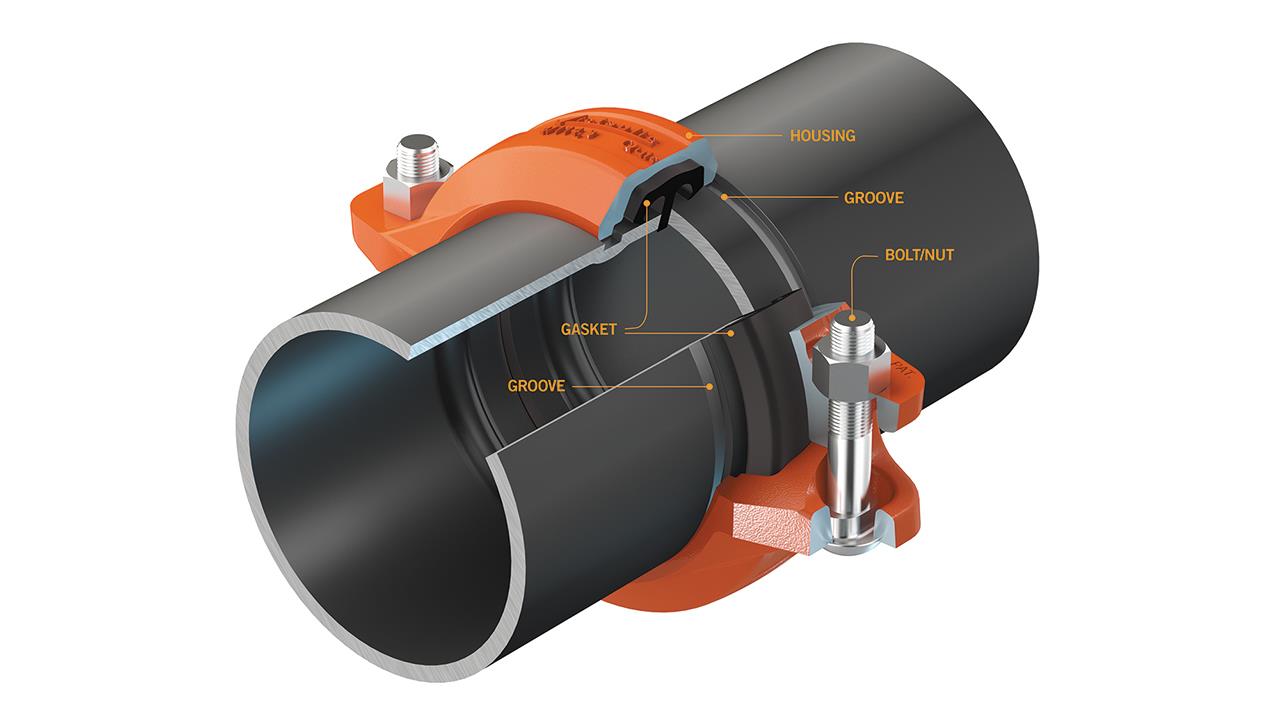

Shaun Hughes, Victaulic Regional Sales Manager, Southern UK, presents the case for grooved mechanical pipe joining.
For as long as modern construction has been around, traditional pipe joining methods, like welding, threading, or flanging, have always been the go-to for contractors, simply because they were the best option at the time. As a result, they are often repackaged again and again within new project specifications.
But what if there is a better solution? What if this inertia is preventing enhanced performance, installation efficiencies, and cost savings from being achieved? Enter grooved mechanical pipe joining.
Effective coupling specification
Although on the surface a similar product to either flanged or welded joints, grooved couplings command contrasting qualities. They’re closest in kind to flanging, in that they involve tightening bolts to join two pipe spools together, but this is where the similarities end. A flanged solution, even at the smallest scale, will require star pattern tightening of four bolts. In contrast, a grooved coupling only requires two bolts to tighten the coupling around the pipe, after being secured within the groove.
Let’s stop for a minute and think about the demands of a modern building project. Construction deadlines are getting shorter, budgets are being tightened, and blueprints are more demanding. Time, cost, and performance – these areas are where contractors are feeling the heat. It’s with these aspects in mind that grooved couplings really appeal as a preferred alternative to the traditional methods.
Time is a finite commodity, especially for contractors, which is why speed and ease of installation is integral. Compared to flanging and the intensive welding process, grooved couplings take on average a sixth of the time to complete the same job.
Installation ease
How do grooved couplings save time during installation? This relates to a number of factors, all combining to create a time-saving solution. Take, for instance, only having to tighten two bolts, a 360° rotation allowing the coupling to be orientated at any angle around the join, and being able to overcome the challenge of finding qualified welders. Bring these factors together and you can see why grooved couplings are giving the traditional methods a run for their money.
For time is money, especially in the construction industry. Extra time on a job equals extra labour costs, extra provision and material renting costs, and potentially a fine for delivering the project past the deadline. Clients and contractors do not want to pay more than they strictly need to and, with budgets being tightened, any time-saving solution is good for the bottom line.
From my personal experience at Victaulic, I have seen countless project managers choose grooved solutions because they save time and money, while increasing efficiencies across the project. Grooved couplings are also making for safer jobsites. There are no open flames required for the welding process and no hazardous fumes released during the installation process.
A shift towards flexibility
Naturally, performance is key as well; you can’t talk about speed and then deliver a product that doesn’t work and isn’t reliable. Certainly, the traditional methods have always reassured contractors with their sturdiness and their reputation of providing a decent outcome.
While grooved solutions certainly give no ground to the traditional joining methods in terms of robustness and reliability – ensured by a triple seal system between groove, gasket, and housing, which is enhanced when pressurised – it’s the additional qualities that have been turning contractors’ heads over the past couple of decades.
Grooved couplings come in two different varieties: rigid, which permits neither linear, angular, or rotational movement at the joints; and flexible, designed to accommodate thermal expansion and contraction, and to allow controlled linear and angular movement at each joint. Employing either one or the other, or a combination of the two, means grooved couplings can be used in virtually every application.
Flexibility really is the buzzword for grooved couplings. Traditional solutions facilitate pipe expansion and contraction by expansion loops, which require extra space, or flex connectors, which are often the weakest point in the system. This is where grooved couplings differ – they save on required space and have a long history of proven reliability.
This is why I believe that grooved couplings are gaining popularity in the industry, and are becoming the preferred alternative to traditional pipe joining.
If you'd like to keep up-to-date with the latest developments in the heating and plumbing industry, why not subscribe to our weekly newsletters? Just click the button below and you can ensure all the latest industry news and new product information lands in your inbox every week.